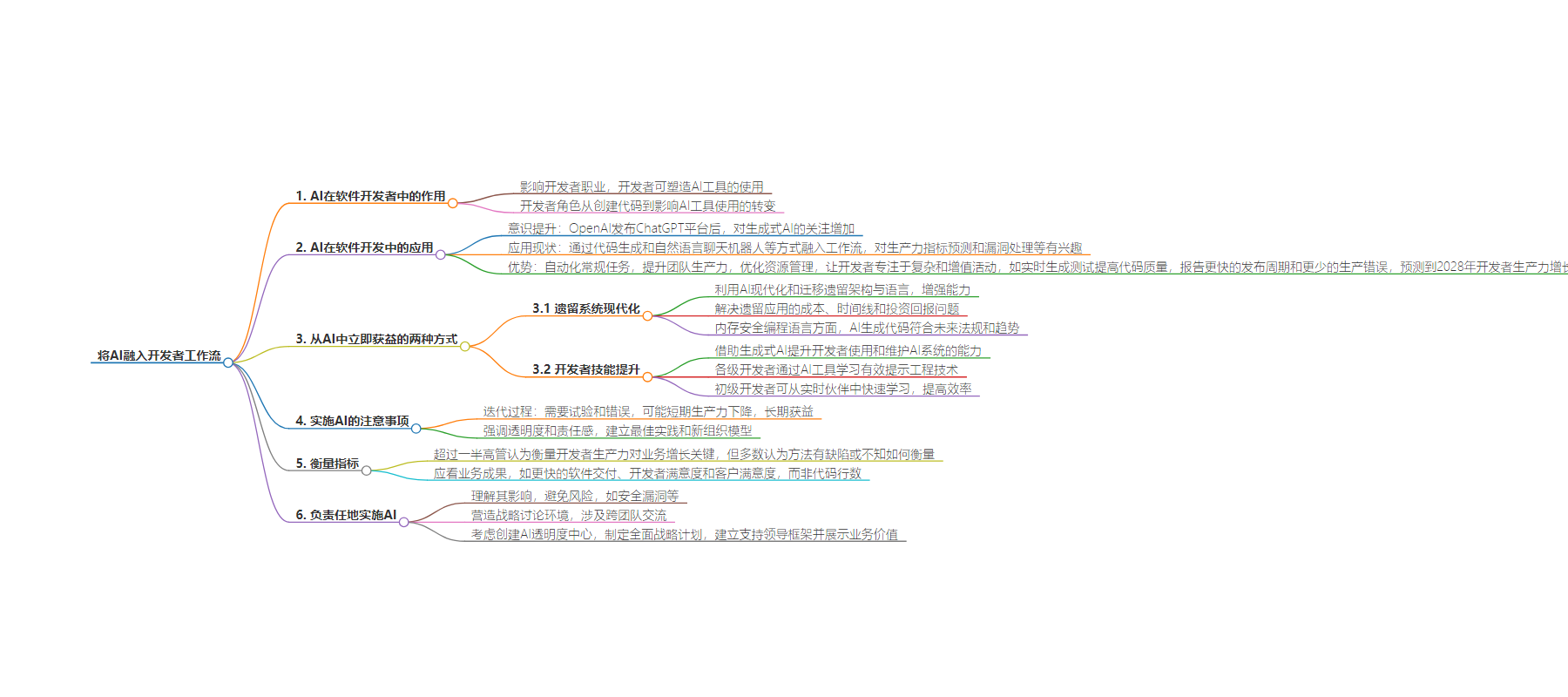包阅导读总结
1.
关键词:AI、开发者工作流、软件开发、价值创造、迭代优化
2.
总结:AI 在软件开发者工作流中的作用日益重要,虽带来挑战但也创造机遇。开发者角色在转变,可通过AI提升效率和价值。组织需合理运用AI,注重迭代、衡量效果和负责任地实施。
3.
主要内容:
– 介绍AI在开发者工作流中的角色转变,从影响开发者职业担忧到发挥积极作用
– 开发者应积极参与AI战略整合
– 对生成式AI的认识提升,其在SDLC中展现价值
– 阐述AI带来的好处
– 自动化常规任务,如实时生成测试提高效率和质量
– 列举立即受益的两种方式
– 遗留系统现代化
– 开发者技能提升
– 强调实施AI的要点
– 需试验和迭代,可能短期生产力下降
– 衡量重要指标,关注业务成果而非代码量
– 负责任地实施AI,避免风险,建立相关环境和框架
思维导图:
文章地址:https://thenewstack.io/prepare-developers-for-integrating-ai-into-their-workflows/
文章来源:thenewstack.io
作者:Brian Wald
发布时间:2024/7/29 14:34
语言:英文
总字数:955字
预计阅读时间:4分钟
评分:86分
标签:人工智能集成,软件开发,开发者生产力,人工智能伦理,遗留系统现代化
以下为原文内容
本内容来源于用户推荐转载,旨在分享知识与观点,如有侵权请联系删除 联系邮箱 media@ilingban.com
AI’s role in democratizing technology is reshaping the way we operate, and software developers are at the heart of this revolution. While many developers fear how AI may affect their careers, they also wield tremendous power in shaping how the revolution plays out. Their role is evolving from code creation to influencing the use of AI tools. Development team leaders who want to unlock the full power of AI should motivate their teams to play an active role in strategically integrating AI into their workflows.
Awareness of generative AI spiked in November 2022 when OpenAI released its ChatGPT platform. Less than two years later, AI-driven software development tools are proving their ability to provide value across the software development life cycle (SDLC). Research from GitLab found that developer teams have already begun applying AI across their workflows through code generation (47%) and natural language chatbots (35%), and they are interested in additional use cases, such as productivity metrics forecasting (38%) and vulnerability explanation and remediation (37%).
Using AI tools to automate routine tasks, such as improving team productivity and optimizing resource management, frees developers to focus their time and attention on more complex and value-adding activities that map directly to business goals.
For example, writing tests is typically a tedious, time-consuming task. Using AI to generate tests in real time ensures thorough coverage and enhances the code’s overall quality. Companies using AI-driven code development tools reported faster release cycles and fewer bugs in production. Gartner predicts that by 2028, the systematic adoption of AI code assistants that began in 2023 will drive at least 36% compounded developer productivity growth.
Two Ways To Immediately Benefit From AI
Developers need toolchains they feel good about using. It’s crucial to have their buy-in as their roles evolve, from writing code to shaping the way they use AI tools and what they generate. By focusing on architecture, quality and performance, developers can use AI to drive greater organizational value.
These two project template examples show quick wins that will benefit almost any software organization.
1. Legacy system modernization: Use AI to modernize and migrate away from legacy architectures and languages, enhancing capabilities in the process. Many organizations struggle with legacy applications due to cost, timeline and return on investment. Typically, they feel forced to choose a path of bare-bones investment, eschewing new features to focus on maintenance and security.
With AI, modernization is frequently cost-justified and achievable on a rapid timeline. Memory-safe programming languages offer an example of where AI can provide clear and immediate benefits. A recent analysis shows that memory safety issues are a leading cause of security vulnerabilities. Since AI can generate code in memory-safe languages today, organizations can have confidence that their refactoring efforts will comply with future regulations and trends toward memory-safe language adoption.
2. Developer upskilling: Generative AI can help you upskill your developers to use and maintain AI systems effectively. Developers at all levels can intuitively learn effective prompt engineering techniques while maintaining coding skills by using AI-powered code-generation tools as they solve problems. Junior developers in particular can benefit from an always-on coding partner to learn from, making them productive, efficient team members more rapidly than ever before.
Iterate, Iterate, Iterate
Implementing AI isn’t like flipping a light switch. Developer teams need a trial-and-error period to determine how AI and other tools mesh with individual workflows. There could be a short-term productivity decline before the organization realizes long-term gains. Leadership should prepare for this by emphasizing transparency and accountability throughout the cycles of development and iteration.
Remember that no tool is ever immediately universally adopted nor deployed with instant maximum efficiency. Once you’ve prepared and trained your DevSecOps teams to use AI, give them time and space to learn how to make it work for your organization’s unique use cases and needs, and work with other teams to establish best practices and new organizational models.
Measure What Matters
GitLab research found that over half (57%) of executives said measuring developer productivity is key to business growth. However, 51% feel their methods for measuring developer productivity are flawed — or they want to measure it but aren’t sure how. Adopting AI in software development introduces an inflection point in the way organizations measure success.
Rather than gauging the impact of software development on the business by looking at raw statistics, such as lines of code produced, organizations can look to business outcomes, such as faster software delivery timelines, developer happiness and increased customer satisfaction scores. Good software development isn’t about generating more lines of code faster; it’s about efficiently solving problems, improving the quality of applications and driving concrete business impact through increased revenue, user adoption and customer satisfaction.
Integrating AI into the software development process can help automate and standardize developer workflows, creating golden paths that reduce cognitive load, free up developers’ time and allow teams to deliver greater value for organizations and end users.
Approach AI Responsibly
Implementing AI without understanding its impact invites risks like security vulnerabilities, fines, customer attrition and reputational damage. Your organization must nurture an environment where strategic discussions about AI are the norm, involving cross-team conversations with technical, legal and AI service providers. Consider creating an AI Transparency Center to guide decision-makers.
AI provides significant advantages, but achieving success necessitates a comprehensive and strategic plan. To prepare your DevSecOps teams, create an environment that leverages AI capabilities within their tools, empowering them to deliver exceptional AI-driven experiences to your application’s users. It is equally important to establish a leadership framework that supports their initiatives and demonstrates business value.
YOUTUBE.COM/THENEWSTACK
Tech moves fast, don’t miss an episode. Subscribe to our YouTubechannel to stream all our podcasts, interviews, demos, and more.
